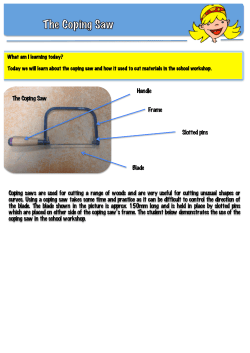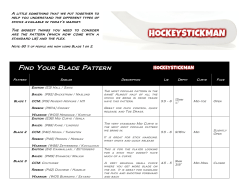
Circular saw benches – Safe working practices HSE information sheet Introduction
Health and Safety Executive Circular saw benches – Safe working practices HSE information sheet Introduction This information sheet is one of a series produced by HSE’s manufacturing sector. It gives practical guidance on safe working practices at circular saw benches. When buying a new circular saw bench, it should be supplied with a declaration of conformity and have a CE Mark. It should be designed and constructed to meet BS EN 1870–1:2007 + A1:2009.1 New saw blades should meet BS EN 847–1:2005.2 Accident history Circular saw benches are the machines that cause the most woodworking accidents. Many of these result in the amputation of fingers. Analysis of accidents investigated by HSE has found that most were caused by inadequate or missing guards. Many of these accidents could have been avoided by having a correctly adjusted saw guard and using a push-stick. Inadequate or lack of training for the operator was also found to be a major cause. It is therefore very important that only properly trained and authorised operators are allowed to use circular saws. Kickback of the workpiece has caused serious and even fatal accidents. General safety issues Risk assessment A risk assessment3 should be carried out covering all foreseeable uses and operations at the circular saw bench. It should identify the action needed to eliminate or control risks. As part of the assessment you should consider if there is a more suitable machine for the process or operation. For example, a properly guarded vertical spindle moulder or router are most suitable for grooving work. Riving knife and saw guard Suitable top guards and riving knives should be fitted to all circular saw benches. It is vital that these are properly adjusted for each job being carried out. Machines should be fully enclosed beneath the table. Information Sheet No 16 (Revision 2) Braking To reduce the risk of contact with the saw blade during run down, machines should be fitted with a braking device that brings the blade to rest within 10 seconds. Unless already fitted with a manual or footoperated brake, circular saw benches with a rundown time greater than 10 seconds should have been fitted with a braking device by 5 December 2003.4,5 Saw blades Dull, badly set and badly ground saw blades produce poor quality work. They also increase the effort required for feeding and the risk of accidents from kickback. Deposits of gum or resin near the teeth tend to cause a saw to stall or the timber to stick. Never try to clean a running blade: stop the saw, remove the blade and use a suitable scraper to remove the resin. Saw blade diameter The diameter of the smallest saw blade that can be safely used should be marked on the machine. A small diameter blade (ie less than 60% of the diameter of the largest blade the saw can accommodate) will have a low peripheral blade speed and will cut inefficiently and increase the risk of kickback. Wood dust Saw benches should be fitted with effective local exhaust ventilation both above and below the table to control wood dust6 (see Figure 1). Workpiece support Adequate workpiece support is essential for all operations at a circular saw bench. Large workpieces should be supported using extension tables or roller supports at both the infeed and outfeed ends. If there is a second operator at the outfeed end to remove cut pieces, the table should be extended so the distance between the saw blade spindle and the rear edge of the table is at least 1200 mm. The second operator should always remain at the outfeed end of the extension and should not reach forward towards the saw. Although the riving knife reduces the risk of contact, it cannot prevent it. 1 of 5 pages Health and Safety Executive Push stick Exhaust outlet Extension table Table Rip fence Riving knife Saw guard Exhaust outlet Cross-cut fence Push stick Figure 1 Circular saw A rip fence or a cross-cut fence should be used to give adequate workpiece support during cutting (see Figure 2(a)). To prevent kickback, the front of the fence must be set no further than the base of the saw blade gullet at table level. When cutting shallow or angled work, the normal fence may need to be replaced with a low fence to aid the use of a push-stick and to prevent the canted saw blade touching the fence (see Figure 2(b)). Push stick Figure 2(b) Low position fence for shallow or angled ripping Use of a push-stick A push-stick should always be used when making any cut less than 300 mm in length or when feeding the last 300 mm of a longer cut. Push-sticks should be at least 450 mm long with a ‘bird’s mouth’ (see Figure 3). The leading hand should never be closer than is necessary to the front of the saw and hands should never be in line with the saw blade. A push-stick should always be used to remove the cut piece from between the saw blade and fence, unless the width of the cut piece exceeds 150 mm. Bird’s mouth Figure 3 Push stick Use of power feed Figure 2(a) Normal fence position for ripping Timber with a round cross-section should not be cut on a bench saw unless the workpiece is adequately supported and held in position by a gripping device. Use a demountable power feed whenever practicable to do so. This reduces the risk of contact with the saw blade (see Figure 4). A demountable power feed unit is not a substitute for a riving knife. The riving knife should be kept in position whenever a demountable power feed is used. 2 of 5 pages Health and Safety Executive E D Note 1: Distance D measured at table level should not exceed 8 mm. For blades greater than 600 mm diameter, E should be at least 225 mm above the table. Guard removed for clarity Figure 4 Using a demountable power feed Figure 6 Riving knife fixing Ripping and cross-cutting Saw guards should: Safe ripping and cross-cutting relies on: ■■ be strong and easily adjustable; ■■ be large enough and shaped so as to enclose ■■ ■■ ■■ ■■ adequate workpiece support; correct positioning of the hands; appropriate use of a push-stick; the correct adjustment of the riving knife and saw guard. as much of the blade as is practicable during the cutting operation; ■■ be kept adjusted as close as possible to the surface of the workpiece (see Figure 7). Riving knives should: ■■ have a chamfered leading edge; ■■ be thicker than the body of the saw blade, but slightly thinner than the width of cut (see Figure 5); A B C Guard Workpiece Note: The saw guard must be adjusted as close to the workpiece as possible Key: A is riving knife thickness B is kerf of saw (width of cut) C is thickness of saw blade body Figure 7 Setting of the saw guard A to be greater than C, but less than B Saw blades should: Figure 5 Thickness of riving knife in relation to the saw blade ■■ be rigid and set accurately in line with the saw; ■■ shaped so the inner edge follows as closely as practicable the contours of the largest saw blade designed to be used on the machine (see Figure 6). ■■ be set so that the teeth project through the surface of the material during cutting; ■■ not, however, be set higher than necessary; ■■ be suitable for the work, ie when cross-cutting on a circular saw bench the ripping blade should be replaced with either a cross-cut or combination blade. 3 of 5 pages Health and Safety Executive Rebating and grooving A circular saw should not be used for cutting a rebate or groove unless the blade is effectively guarded. This is because the normal saw guard cannot be used. Suitable alternative guards and fixtures are necessary. Figure 8 shows an example of one method for rebating or grooving using Shaw guards. Where practicable, the tunnel formed by the pressure pads should be designed to meet the requirements of BS EN ISO 13857:2008.7 Saw guard with exhaust outlet Workpiece Fence canted End cleat Fence Figure 9(a) Bevel ripping Workpiece Saddle Fence Figure 8 Saw guard for rebating and grooving on a saw bench Stopped grooving should not be done on a circular sawing machine. This should be done on a vertical spindle moulding machine or a hand/pin routing machine. End cleat 45o Angled cutting and bevelling Angled cuts can be made on a tilting arbour saw by inclining the saw blade to the required angle and feeding the workpiece as for ripping or cross-cutting. The saw guard must be suitable for this operation and be designed so that it prevents the risk of contact with the inclined blade. The fence should be set in its low position or an auxiliary fence used to prevent the possibility of the fence touching the rotating saw blade. Section produced Figure 9(b) Angle ripping On machines with a fixed position spindle, a simple jig may be constructed to give adequate workpiece support during the cutting operation (see Figures 9(a) and 9(b)). 4 of 5 pages Health and Safety Executive References Further reading 1 BS EN 1870–1:2007 + A1:2009 Safety of woodworking machines. Circular sawing machines. Circular saw benches (with and without sliding table), dimension saws and building site saws British Standards Institution Safe use of work equipment. Provision and Use of Work Equipment Regulations 1998. Approved Code of Practice and guidance L22 (Third edition) HSE Books 2008 ISBN 978 0 7176 6295 1 www.hse.gov.uk/pubns/books/l22.htm 2 BS EN 847–1:2005 Tools for woodworking. Safety requirements. Milling tools, circular saw blades British Standards Institution While every effort has been made to ensure the accuracy of the references listed in this publication, their future availability cannot be guaranteed. 3 Management of health and safety at work. Management of Health and Safety at Work Regulations 1999. Approved Code of Practice and guidance L21 (Second edition) HSE Books 2000 ISBN 978 0 7176 2488 1 www.hse.gov.uk/pubns/priced/l21.pdf 4 Safe use of woodworking machinery. Provision and Use of Work Equipment Regulations 1998 as applied to woodworking machinery. Approved Code of Practice and guidance L114 HSE Books 1998 ISBN 978 0 7176 1630 5 www.hse.gov.uk/pubns/books/l114.htm 5 PUWER 98: Retrofitting of braking to woodworking machines Woodworking Information Sheet WIS38 HSE Books 1998 www.hse.gov.uk/pubns/woodindx.htm 6 LEV: General principles of system design Woodworking Information Sheet WIS23 HSE Books 1992 www.hse.gov.uk/pubns/woodindx.htm (A revised version of WIS23 is due to be published in 2012 as Wood dust and how to control it) 7 BS EN ISO 13857:2008 Safety of machinery. Safety distances to prevent hazard zones being reached by upper and lower limbs British Standards Institution Further information More information on circular saws, including videos illustrating correct working practices and a circular sawing machines poster, can be found on HSE’s woodworking website: www.hse.gov.uk/woodworking.htm. For information about health and safety, or to report inconsistencies or inaccuracies in this guidance, visit www.hse.gov.uk/. You can view HSE guidance online and order priced publications from the website. HSE priced publications are also available from bookshops. British Standards can be obtained in PDF or hard copy formats from BSI: http://shop.bsigroup.com or by contacting BSI Customer Services for hard copies only Tel: 020 8996 9001 email: cservices@bsigroup.com. This information sheet contains notes on good practice which are not compulsory but which you may find helpful in considering what you need to do. This document is available at: www.hse.gov.uk/pubns/wis16.pdf. © Crown copyright If you wish to reuse this information visit www.hse.gov.uk/copyright.htm for details. First published 11/11. Published by the Health and Safety Executive WIS16 11/11 5 of 5 pages
© Copyright 2025


















